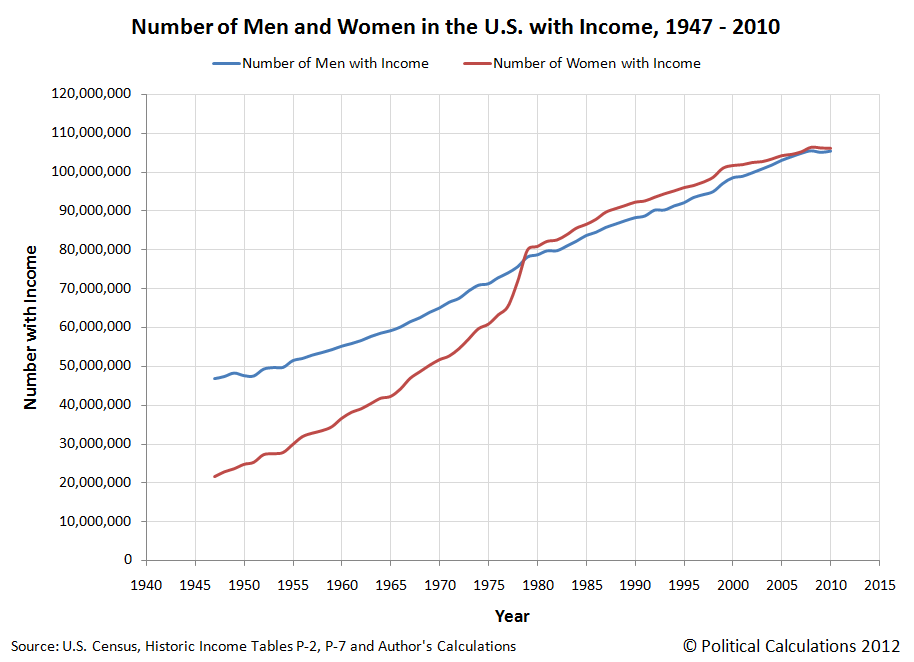Which modern era President has done the most to materially improve the fortunes of women in the United States? Going back to 1947, when the U.S. Census began collecting data on income earners in the U.S., the choices are:
- Harry Truman (D)
- Dwight Eisenhower (R)
- John Kennedy (D)
- Lyndon Johnson (D)
- Richard Nixon (R)
- Gerald Ford (R)
- James Carter (D)
- Ronald Reagan (R)
- George H.W. Bush (R)
- William Clinton (D)
- George W. Bush (R)
- Barack Obama (D)
To answer the question, we began with the chart we previously featured showing the change in the number of men and women earning incomes in the United States, we discovered a unique surge in the number of women with incomes occurring from the years spanning 1977 through 1979, as the number of U.S. women counted as earning incomes surged by over 14.5 million:
While occurring during Jimmy Carter's presidency, which ran from 1977 through 1980, the real credit for this achievement belongs to Gerald Ford.
Here's how we know. Digging deeper into the U.S. Census' data, we found that the surge in the number of American women earning incomes occurred entirely within the ranks of those who do not earn wage or salary income:
Digging even deeper into the data, we found an even more impressive increase, as the number of women earning interest income skyrocketed from 15,435,000 in 1977 to 48,702,000 in 1979 - more than tripling in number over a two year period! And though these numbers include a large number of women with wage and salary or other income, it appears to us to have swept up some 14.5 million women who had no other source of income before, which accounts for the tremendous increase we observe in the number of women earning non-wage or salary income in the U.S. during these years.
We found the reason for this dramatic increase in the passage of the Equal Credit Opportunity Act of 1974, which was subsequently amended in 1976. Both measures were signed into law by President Gerald Ford and opened the door to women having direct access to credit.
Here, the original Equal Credit Opportunity Act (ECOA) sought to eliminate discrimination in the ability of women to obtain credit, which charged the Federal Reserve with implementing the new non-discriminatory policy in the nation's financial institutions in 1975.
However, the data for the number of women earning incomes indicates that this measure failed to achieve its purpose in the years immediately following its implementation, because the bill's principal author, Representative Bella Abzug (D-NY), failed to foresee that other means of discrimination, such as for race and other personal attributes, might be used to deny women access to credit.
In response, in November 1975, President Gerald Ford recommended that the law be broadened to include these categories. That action was achieved by the ECOA Amendments of 1976, which President Ford signed into law on 23 March 1976. The provision of those amendments were subsequently encoded into the Federal Reserve's Regulation B on 29 December 1976, which were scheduled to take effect on 23 March 1977.
Since the U.S. Census takes its Current Population Survey in March of each year, the Current Population Report for 1977 nearly perfectly captures the effects of the ECOA Amendments of 1976, as the pre-implementation number of women earning interest income, which came about as they opened bank accounts to gain access to credit, rose from 15,435,000 in 1977 to 30,155,000 in 1978, before more than tripling to reach 48,702,000 in 1979 before stabilizing to grow at a slow and steady rate ever since in 1980.
So not only did President Ford do the most of all modern-era U.S. Presidents to materially improve the fortunes of women in the U.S., he also did the most for minority women.
It's kind of interesting to review the histories published by various feminist organizations such as the National Organization of Women or other timelines that make either no mention or only token mentions of this achievement. It's almost as if they weren't really engaged in what is clearly the most successful program to eliminate discrimination against women in the post World War 2 era in the United States. We wonder if that might have something to do with some pretty notable failures, aside from Bella Abzug's poor legislative foresight, that other leading feminists have had in that area.
References
Board of Governors of the Federal Reserve System. Regulation B; Docket No. R-1008. 1998.
Cubita, Peter N. and Hartmann, Michelle. The ECOA Discrimination Proscription and Disparate Impact - Interpreting the Meaning of the Words That Actually Are There. The Business Lawyer, Vol. 61, No. 2. February 2006. [Ungated version].
Ford, Gerald M. Statement on the Signing of the Equal Credit Opportunity Act Amendments of 1976. 23 March 1976.
Mailliard, Page and Anderson, Ken. Women's Banks and Women's Access to Credit: Competition Between Marketplace and Regulatory Solutions to Gender Discrimination. 20 Loy. L.A. L. Rev. 771 (1987). [PDF document].
U.S. Census. Historical Income Tables: People. Table P-2. Race and Hispanic Origin of People by Median Income and Sex: 1947 to 2010. [Excel Spreadsheet]. September 2011.
U.S. Census. Historical Income Tables: People. Table P-53. Wage or Salary Workers (All) by Median Wage and Salary Income and Sex: 1947 to 2010. [Excel Spreadsheet]. September 2011.
U.S. Census. Money Income in 1977 of Families and Persons, in the United States. Current Population Reports, P-60, No. 118, Table 49. [PDF document]. March 1979.
U.S. Census. Money Income in 1978 of Families and Persons, in the United States. Current Population Reports, P-60, No. 123, Table 53. [PDF document]. March 1979.
U.S. Census. Money Income in 1979 of Families and Persons, in the United States. Current Population Reports, P-60, No. 129, Table 55. [PDF document]. March 1979.
Labels: data visualization, demographics, economics
Welcome to the blogosphere's toolchest! Here, unlike other blogs dedicated to analyzing current events, we create easy-to-use, simple tools to do the math related to them so you can get in on the action too! If you would like to learn more about these tools, or if you would like to contribute ideas to develop for this blog, please e-mail us at:
ironman at politicalcalculations
Thanks in advance!
Closing values for previous trading day.
This site is primarily powered by:
CSS Validation
RSS Site Feed
JavaScript
The tools on this site are built using JavaScript. If you would like to learn more, one of the best free resources on the web is available at W3Schools.com.


